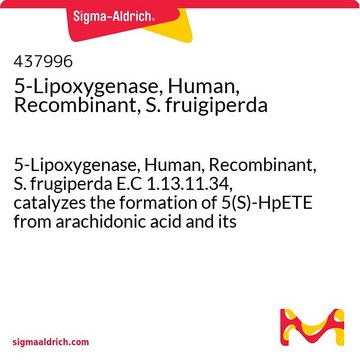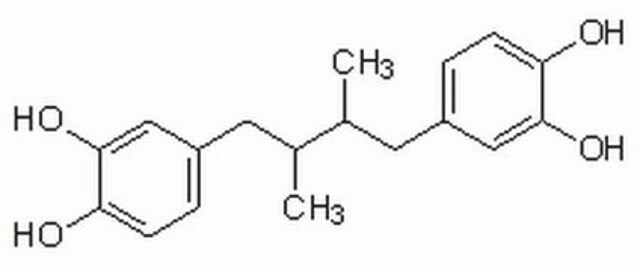Kluczowe dokumenty
L7395
Lipoxidase from Glycine max (soybean)
Type I-B, lyophilized powder, ≥50,000 units/mg solid
Synonim(y):
15-lipoxygenase, LOX A, Linoleate:oxygen oxidoreductase, Lipoxygenase
About This Item
Polecane produkty
typ
Type I-B
Poziom jakości
Postać
lyophilized powder
aktywność właściwa
≥50,000 units/mg solid
masa cząsteczkowa
94 kDa
Warunki transportu
wet ice
temp. przechowywania
−20°C
Szukasz podobnych produktów? Odwiedź Przewodnik dotyczący porównywania produktów
Opis ogólny
Zastosowanie
- to study the effects of 2-(α-D-glucopyranosyl)methyl-2,5,7,8-tetramethylchroman-6-ol(TMG) on oxidation of lipoproteins
- as a representative enzyme for lipoxygenases in microplate assay platform to screen for enzymes degrading wood extractives
- as a positive control in lipoxygenase inhibitory activity assay
Działania biochem./fizjol.
Definicja jednostki
Postać fizyczna
Hasło ostrzegawcze
Danger
Zwroty wskazujące rodzaj zagrożenia
Zwroty wskazujące środki ostrożności
Klasyfikacja zagrożeń
Resp. Sens. 1
Kod klasy składowania
11 - Combustible Solids
Klasa zagrożenia wodnego (WGK)
WGK 1
Temperatura zapłonu (°F)
Not applicable
Temperatura zapłonu (°C)
Not applicable
Środki ochrony indywidualnej
Eyeshields, Gloves, type N95 (US)
Certyfikaty analizy (CoA)
Poszukaj Certyfikaty analizy (CoA), wpisując numer partii/serii produktów. Numery serii i partii można znaleźć na etykiecie produktu po słowach „seria” lub „partia”.
Masz już ten produkt?
Dokumenty związane z niedawno zakupionymi produktami zostały zamieszczone w Bibliotece dokumentów.
Klienci oglądali również te produkty
Nasz zespół naukowców ma doświadczenie we wszystkich obszarach badań, w tym w naukach przyrodniczych, materiałoznawstwie, syntezie chemicznej, chromatografii, analityce i wielu innych dziedzinach.
Skontaktuj się z zespołem ds. pomocy technicznej








